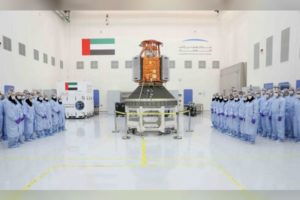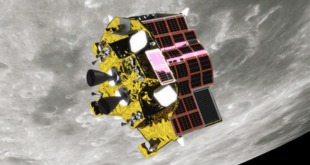
KhalifaSat, the UAE Earth observation system that is also the first Emirati-built satellite, will be launched from Japan on 29 October 2018.
KhalifaSat has been in development since 2013, and will be lofted into orbit from the Tanegashima Space Centre in Japan. The earth observation satellite will join the UAE’s two imaging satellites already in orbit, DubaiSat-1 and DubaiSat-2.
KhalifaSat was designed, tested, built, and managed by Emirati engineers at the Mohammed bin Rashid Space Centre’s (MBRSC) Advanced Technology Laboratories in Dubai, making it the first satellite system to be developed at the facility. In July 2018, the director-general of the UAE Space Agency Mohammed Al Ahbabi said that the UAE will boost investment in the space sector to AED 22 billion (approximately U.S.$5 billion) by having ten multi-purpose satellites.
Yousuf Hamad Al Shaibani, director general of the MBRSC, said: “KhalifaSat is a unique Earth observation satellite which aims to serve humanity.
“This confirms that the strategy adopted by MBRSC to prepare and train Emirati scientists and engineers is successful, and we are on the right track to turn Dubai into a global hub for space technology,” said Al Shaibani.
Sheikh Hamdan bin Mohammed bin Rashid Al Maktoum, Crown Prince of Dubai and chairman of the MBRSC, said the launch of KhalifaSat is an important step towards achieving the UAE’s space strategy.
“This is an important milestone for our country, an achievement made possible because our leadership supports Emirati youth and encourages them to excel in the fields of innovation and technological development,” he said.
Mohammed Al Ahbabi said that KhalifaSat project has contributed during all its stages of design and manufacturing in developing national capabilities for satellite manufacturing that will be an essential factor in developing the UAE space sector.
“All engineers working on Khalifasat’s project should be proud of what they have achieved during the development phase” added Al Ahbabi.
 SpaceWatch.Global An independent perspective on space
SpaceWatch.Global An independent perspective on space




